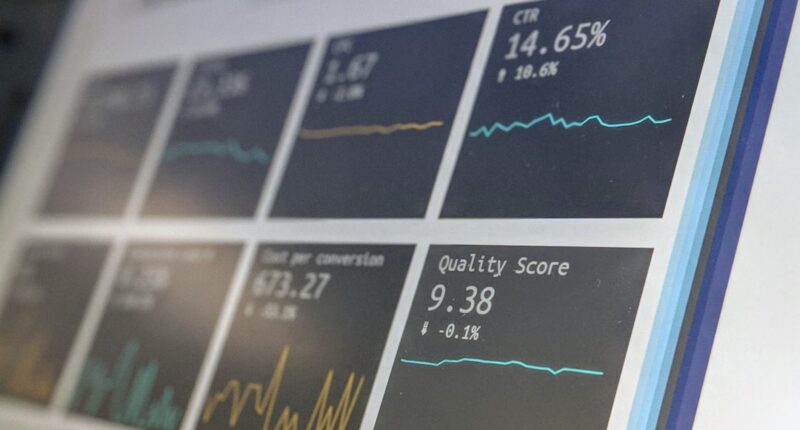NFTs, or non-fungible tokens, have taken the digital world by storm. These unique digital assets have gained popularity in various industries, including art, gaming, and collectibles. As the NFT market continues to grow, the need for analytics tools to track and analyze data becomes increasingly important.
Analytics plays a crucial role in any market, and the NFT market is no exception. By utilizing analytics tools, individuals and businesses can gain valuable insights into the trends and patterns within the NFT market. These insights can help inform decision-making, identify potential opportunities, and mitigate risks.
In this blog post, we will explore the importance of data in the NFT market and how analytics tools can help in decision-making. We will also delve into the impact of Ethereum on NFTs and how recent news and updates on Ethereum can affect the NFT market. Additionally, we will discuss the role of Ethereum news in NFT analytics and explore current trends and developments in the NFT market. Finally, we will provide an overview of the top NFT analytics tools available and offer tips on how to use them effectively.
Key Takeaways
- NFT analytics tools are essential for making informed decisions in the NFT market.
- Data plays a crucial role in understanding NFT trends and making profitable investments.
- Ethereum is the leading blockchain platform for NFTs, with a vast ecosystem of tools and resources.
- Keeping up with Ethereum news is crucial for understanding the impact on NFTs and making informed decisions.
- Top NFT analytics tools include NonFungible, DappRadar, and Nansen, among others.
The Importance of Data in NFTs
Data is a valuable asset in any market, and the NFT market is no different. In fact, data is even more crucial in the world of NFTs due to their unique nature. Unlike traditional assets, NFTs are indivisible and cannot be exchanged on a like-for-like basis. This makes it essential to have access to accurate and comprehensive data to make informed decisions.
Analytics tools play a vital role in collecting, organizing, and analyzing data related to NFTs. These tools can provide insights into various aspects of the NFT market, such as pricing trends, popularity of certain artists or collections, and buyer behavior. By leveraging these insights, individuals and businesses can make more informed decisions about buying, selling, and investing in NFTs.
Furthermore, analytics tools can help identify trends and patterns within the NFT market. By analyzing historical data, these tools can uncover patterns that may not be immediately apparent to the naked eye. This can be particularly useful for identifying emerging artists or collections that have the potential for future growth. By staying ahead of trends, individuals and businesses can position themselves for success in the NFT market.
Ethereum and NFTs: A Brief Overview
Ethereum is a blockchain platform that has become synonymous with NFTs. It provides the infrastructure for creating, buying, and selling NFTs, making it the go-to platform for many artists, collectors, and investors.
One of the key benefits of using Ethereum for NFTs is its smart contract functionality. Smart contracts are self-executing contracts with the terms of the agreement directly written into code. In the context of NFTs, smart contracts enable artists to create unique digital assets and specify the terms of their sale or licensing. This ensures that ownership and provenance of NFTs can be easily verified on the blockchain.
Additionally, Ethereum’s decentralized nature allows for greater transparency and security in the NFT market. Transactions on the Ethereum blockchain are recorded on a public ledger, making it difficult to alter or manipulate data. This provides a level of trust and authenticity that is crucial in the world of digital assets.
Ethereum News and Its Impact on NFTs
As one of the leading blockchain platforms for NFTs, any news or updates related to Ethereum can have a significant impact on the NFT market. Changes to Ethereum’s technology or policies can affect how NFTs are created, bought, sold, and traded.
For example, recent updates to Ethereum’s gas fees have had a direct impact on the cost of minting and trading NFTs. Gas fees are transaction fees paid to miners on the Ethereum network to process and validate transactions. High gas fees can make it expensive for artists to mint NFTs or for collectors to buy and sell them. Conversely, lower gas fees can make NFTs more accessible and affordable for a wider audience.
Staying up-to-date with Ethereum news is crucial for anyone involved in the NFT market. By being aware of changes and updates, individuals and businesses can adapt their strategies and make informed decisions. This includes monitoring gas fees, understanding any changes to Ethereum’s technology or policies, and staying informed about upcoming developments that may impact the NFT market.
Eth News: How It Affects NFT Analytics
Ethereum news has a direct impact on NFT analytics. Changes in Ethereum’s technology or policies can affect the data collected by analytics tools and the insights derived from that data.
For example, if Ethereum were to implement a new fee structure or change its gas fee algorithm, this would directly impact the cost of minting and trading NFTs. Analytics tools would need to be updated to reflect these changes in order to provide accurate cost projections and pricing trends.
Monitoring Ethereum news is therefore essential for NFT analytics. By staying informed about changes and updates, individuals and businesses can ensure that their analytics tools are up-to-date and providing accurate insights. This allows for more informed decision-making and reduces the risk of making decisions based on outdated or inaccurate data.
There have been several instances in the past where Ethereum news has had a significant impact on NFT analytics. For example, when Ethereum introduced its London hard fork in August 2021, it included a change to the gas fee structure known as EIP-1559. This change resulted in a reduction in gas fees, making it more affordable for artists to mint NFTs and for collectors to buy and sell them. This had a direct impact on pricing trends within the NFT market, as lower gas fees made NFTs more accessible and affordable for a wider audience.
NFT News: Trends and Developments

In addition to monitoring Ethereum news, it is also important to stay informed about current trends and developments in the NFT market. The NFT market is constantly evolving, with new artists, collections, and platforms emerging on a regular basis.
By staying up-to-date with NFT news, individuals and businesses can identify emerging trends and developments that may impact the market. This includes keeping an eye on popular artists or collections, new platforms or marketplaces, and any regulatory or legal changes that may affect the NFT market.
For example, the rise of celebrity NFTs has been a significant trend in the NFT market. Celebrities from various industries, including music, sports, and entertainment, have embraced NFTs as a way to engage with their fans and monetize their digital content. By staying informed about these trends, individuals and businesses can identify potential investment opportunities or collaborations with celebrity artists.
Developments in NFT technology are also worth monitoring. For example, advancements in blockchain technology may enable new features or functionalities for NFTs, such as enhanced interactivity or programmability. These developments can open up new possibilities for artists and collectors and may impact the value and demand for certain types of NFTs.
Top NFT Analytics Tools for Better Decision-Making
Now that we understand the importance of data in the NFT market and how Ethereum news can impact NFT analytics, let’s explore some of the top NFT analytics tools available.
1. NonFungible.com: NonFungible.com is a comprehensive analytics platform that provides insights into various aspects of the NFT market. It offers data on sales volume, average prices, top collections, and more. The platform also provides tools for tracking specific NFTs or portfolios and offers customizable alerts for price changes or new listings.
2. DappRadar: DappRadar is a popular analytics platform that focuses on decentralized applications (dapps), including NFT marketplaces. It provides data on the number of users, transaction volume, and other metrics for various NFT marketplaces. This can be useful for identifying popular platforms and understanding user behavior within the NFT market.
3. CryptoSlam: CryptoSlam is a platform that specializes in tracking and analyzing NFT sales and collections. It provides data on sales volume, average prices, and top sellers for various NFT projects. The platform also offers insights into the popularity of specific artists or collections, allowing users to identify emerging trends or potential investment opportunities.
These are just a few examples of the many NFT analytics tools available. Each tool offers its own unique features and capabilities, so it is important to explore different options and find the one that best suits your needs.
How to Use NFT Analytics Tools Effectively
Using NFT analytics tools effectively requires a strategic approach and an understanding of best practices. Here are some tips for maximizing the benefits of NFT analytics tools:
1. Define your goals: Before using an analytics tool, it is important to define your goals and objectives. What insights are you looking to gain? Are you interested in tracking specific artists or collections? Do you want to monitor pricing trends or buyer behavior? By clearly defining your goals, you can focus your efforts on collecting and analyzing the most relevant data.
2. Choose the right tool: As mentioned earlier, there are many NFT analytics tools available, each with its own unique features and capabilities. Take the time to research different tools and choose the one that best aligns with your goals and objectives. Consider factors such as data accuracy, user interface, and customer support when making your decision.
3. Stay up-to-date: The NFT market is constantly evolving, and new trends and developments can emerge at any time. It is important to stay up-to-date with the latest news and updates in order to make informed decisions. This includes monitoring Ethereum news, staying informed about current trends in the NFT market, and regularly updating your analytics tools to reflect any changes or updates.
4. Combine data sources: NFT analytics tools provide valuable insights, but they are not the only source of data. Consider combining data from multiple sources, such as social media platforms, NFT marketplaces, and artist websites, to gain a more comprehensive view of the market. This can help identify emerging trends or patterns that may not be immediately apparent from a single data source.
5. Experiment and iterate: NFT analytics is a dynamic field, and what works today may not work tomorrow. It is important to experiment with different strategies and approaches and iterate based on the insights gained. This includes trying out different analytics tools, exploring new data sources, and adapting your strategies based on changing market conditions.
Case Studies: Successful NFT Analytics Implementation
To further illustrate the benefits of NFT analytics tools, let’s explore some case studies of successful implementation:
1. Beeple’s “Everydays: The First 5000 Days”: Beeple is a digital artist who gained widespread recognition for his NFT artwork. His most famous piece, “Everydays: The First 5000 Days,” sold for a record-breaking $69 million at auction. Beeple’s success can be attributed in part to his use of analytics tools to track pricing trends and buyer behavior. By leveraging these insights, Beeple was able to strategically price his artwork and target the right audience.
2. NBA Top Shot: NBA Top Shot is an NFT platform that allows fans to collect and trade digital basketball highlights. The platform has seen tremendous success, with millions of dollars in sales volume. NBA Top Shot utilizes analytics tools to track user behavior and identify popular moments or players. This allows the platform to curate collections and highlight trending content, resulting in increased engagement and sales.
3. CryptoPunks: CryptoPunks is one of the earliest and most successful NFT projects. Each CryptoPunk is a unique digital avatar with its own set of attributes. The project gained popularity in part due to its use of analytics tools to track sales volume and popularity. By analyzing this data, the creators of CryptoPunks were able to identify emerging trends and adjust their strategies accordingly, leading to increased demand and value for their digital avatars.
These case studies demonstrate the power of NFT analytics in driving long-term success. By leveraging data and insights, individuals and businesses can make informed decisions, identify emerging trends, and position themselves for success in the NFT market.
Leveraging NFT Analytics for Long-Term Success
In conclusion, NFT analytics tools play a crucial role in the NFT market by providing valuable insights into trends, patterns, and buyer behavior. By leveraging these insights, individuals and businesses can make more informed decisions about buying, selling, and investing in NFTs.
Ethereum news also has a direct impact on NFT analytics, as changes to Ethereum’s technology or policies can affect how NFTs are created, bought, sold, and traded. Staying up-to-date with Ethereum news is therefore essential for anyone involved in the NFT market.
Furthermore, staying informed about current trends and developments in the NFT market is crucial for identifying emerging opportunities and understanding user behavior. By combining data from multiple sources and experimenting with different strategies, individuals and businesses can maximize the benefits of NFT analytics tools.
In summary, leveraging NFT analytics is key to long-term success in the ever-evolving world of NFTs. By staying informed, utilizing the right tools, and making data-driven decisions, individuals and businesses can navigate the NFT market with confidence and achieve their goals.
If you’re interested in diving deeper into the world of NFTs and exploring the latest news and developments, you should definitely check out ETH News. They provide comprehensive coverage on all things related to Ethereum and blockchain technology. One article that caught my attention is “Hello World: A Beginner’s Guide to NFTs.” This informative piece serves as a great starting point for those looking to understand the basics of non-fungible tokens and how they are revolutionizing various industries. Read more
FAQs
What are NFT analytics tools?
NFT analytics tools are software programs that collect and analyze data related to non-fungible tokens (NFTs). These tools provide insights into the performance of NFTs, including sales data, market trends, and user behavior.
Why are NFT analytics tools important?
NFT analytics tools are important because they provide valuable data that can be used to make informed decisions about buying, selling, and trading NFTs. By analyzing market trends and user behavior, these tools can help investors and collectors make better decisions about which NFTs to invest in.
What types of data do NFT analytics tools collect?
NFT analytics tools collect a wide range of data related to NFTs, including sales data, market trends, user behavior, and transaction history. This data can be used to identify popular NFTs, track market trends, and analyze user behavior.
How do NFT analytics tools work?
NFT analytics tools work by collecting data from various sources, including NFT marketplaces, social media platforms, and blockchain networks. This data is then analyzed using algorithms and machine learning models to identify patterns and trends.
What are some popular NFT analytics tools?
Some popular NFT analytics tools include NonFungible.com, DappRadar, and CryptoSlam. These tools provide valuable insights into the NFT market, including sales data, market trends, and user behavior.
How can NFT analytics tools be used for decision-making?
NFT analytics tools can be used for decision-making by providing valuable insights into the NFT market. By analyzing market trends and user behavior, these tools can help investors and collectors make informed decisions about which NFTs to invest in.





